This post is largely about behavior. The image quality ranges from good to mediocre but I think each photo contributes something to a better understanding of magpies.
Black-billed Magpies begin nest-building as early as January and these particular birds have been at it for several weeks now. Actually, in this case it’s more a “remodel” than it is “new construction” since this nest has been used for at least the last three years.
All of these photos have been taken this week, which accounts for the relatively bright snow and ice background in some of the shots.
1/2500, f/7.1, ISO 500, 500 f/4, natural light
One of the first things you may notice is the fact that sometimes these Black-billed Magpies don’t seem to have black bills. Part of nest construction involves mud gathering and the drying mud on the bill can significantly alter the appearance of the bill.
1/2500, f/7.1, ISO 500, 500 f/4, natural light
Both sexes contribute to nest construction and they’re quite industrious in their efforts. The size of the twigs they bring in is often impressive.
1/4000, f/7.1, ISO 500, 500 f/4, natural light
The nest is buried deep in a greasewood bush at about eye level for me. Typically a bird bringing in construction material will land on a nearby perch and look over the nest for a few moments – seeming to plan placement of the twig and an approach path through the myriad of vertical greasewood stems that present significant obstacles to proper placement of such an unwieldy object.
1/4000, f/7.1, ISO 500, 500 f/4, natural light
Then they launch and dive directly into the tangled thicket with the twig.
1/1600, f/7.1, ISO 500, 500 f/4, natural light
They range far and wide for construction materials, occasionally bringing them in from very far away. Sometimes they rob another abandoned magpie nest in the vicinity but they’ll also use twigs they find on the ground near the nest. This bird is picking one up within a few feet of the nest. Part of the reason I’m including this shot is to show the blue-white nictitating membrane that I “complained” about in a recent post.
1/3200, f/6.3, ISO 500, 500 f/4, natural light
Another twig going into the nest.
1/2000, f/7.1, ISO 500, 500 f/4, natural light
This is the obstacle course that the birds must negotiate with an awkward twig in their bill. The top of the nest dome is the mass of matted nesting material on the right. An average nest is about 30″ high and 20″ wide but this particular nest is larger, probably because it has been used and added to for several years.
Magpie nests are relatively complex structures. Overall design can vary but often, as in this case, they’re domed structures made of sticks and twigs with an interior mud bowl lined with rootlets, grass and mammal hair which provides excellent insulation for the incubating female. Here’s a link to a photo of a magpie nest with the covering dome removed so the mud bowl can clearly be seen.
1/2500, f/7.1, ISO 500, 500 f/4, natural light
When the twig they bring in has multiple branches the magpies really struggle to get it through the maze of greasewood twigs to the nest. I swear that these birds actually plan their approach through the obstacle course from the nearby perch that they often use – which is what this bird seems to be doing.
1/2000, f/7.1, ISO 500, 500 f/4, natural light
At times both birds arrive at the nest with twigs at the same time. The female is slightly smaller so I believe that’s her on the left.
1/1600, f/7.1, ISO 500, 500 f/4, natural light
It can be quite comical to watch them struggle as the try to place the stick in precisely the “right” spot.
1/2000, f/6.3, ISO 500, 500 f/4, natural light
This bird was flying around at the base of the nest as it looked for appropriate building materials there.
1/2500, f/5.6, ISO 640, 500 f/4, natural light
The male contributes more to construction of the nest superstructure than the female but the female builds most of the interior mud bowl and lining. Right now mud is readily available due to melting snow. This bird is diving down from the nest, most likely to look for mud for the nest cup.
1/1600, f/7.1, ISO 500, 500 f/4, natural light
Once the bird has a beak full of mud it will often pick up small bits of grass, tiny twigs or other vegetation to mix in with the mud before it flies in to the nest. Here the bird has the “proper” mixture and is looking up at the nest just prior to take-off.
1/1600, f/7.1, ISO 500, 500 f/4, natural light
When the bird launched the angle to the sun was just right to really show off the iridescence. The head could be a tad sharper but I really like the curves and colors of the wing and tail.
There is significant variation in structural design of magpie nests from region to region. Research suggests that “cultural traditions” influence nest construction and that perhaps magpies imprint on their natal nests as a model for their own nest construction.
I find that possibility fascinating.
Ron


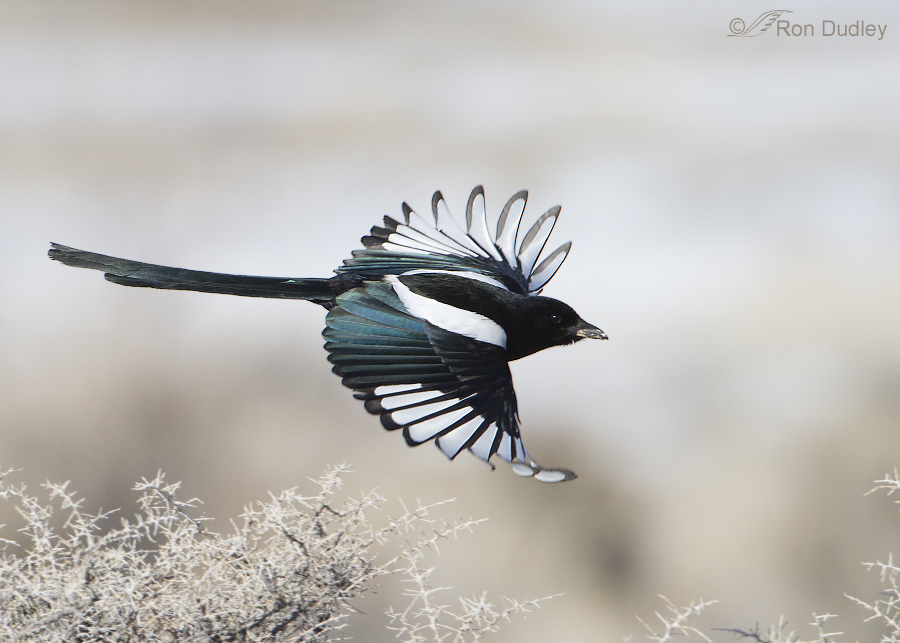
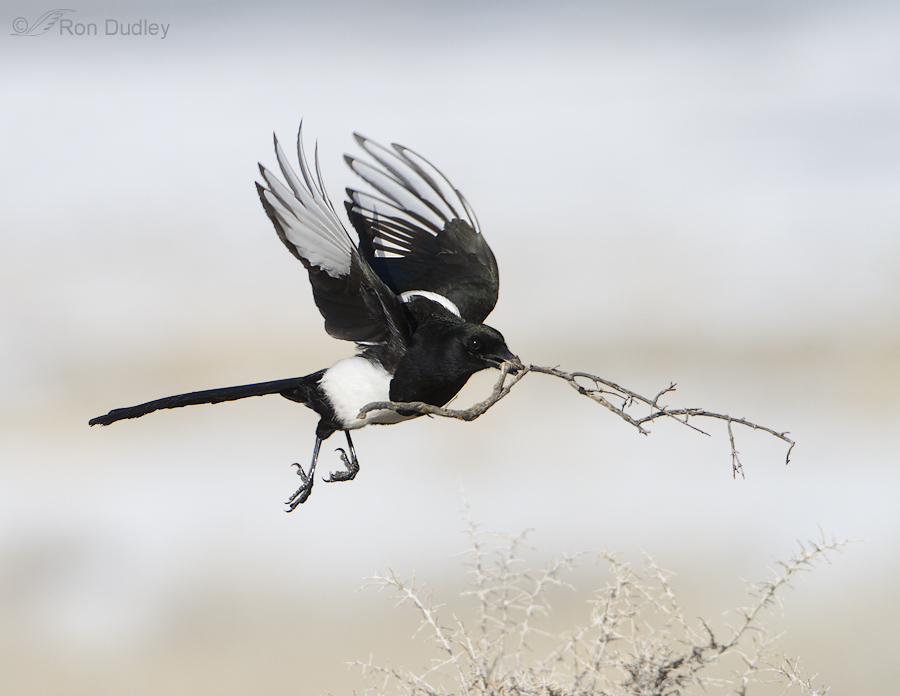
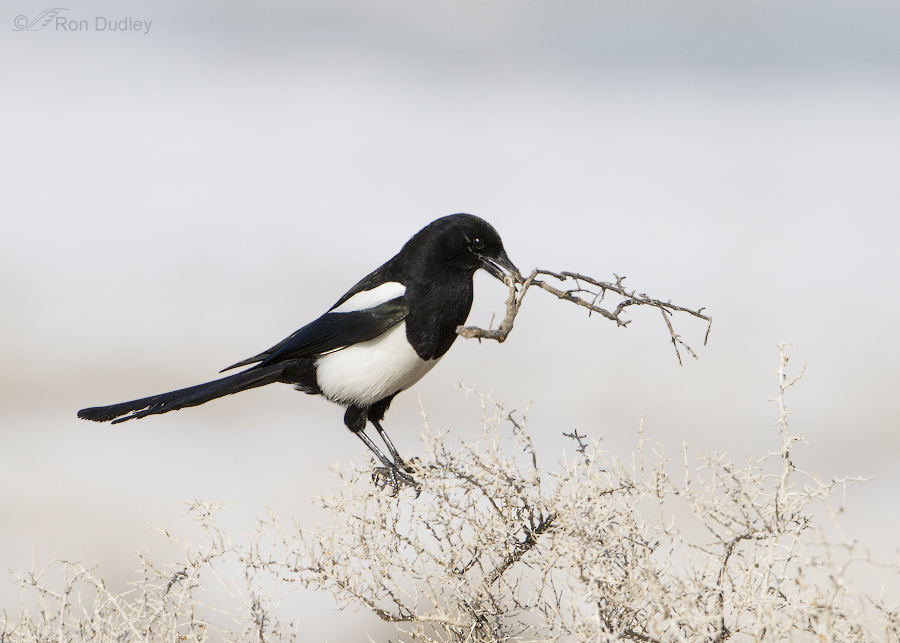
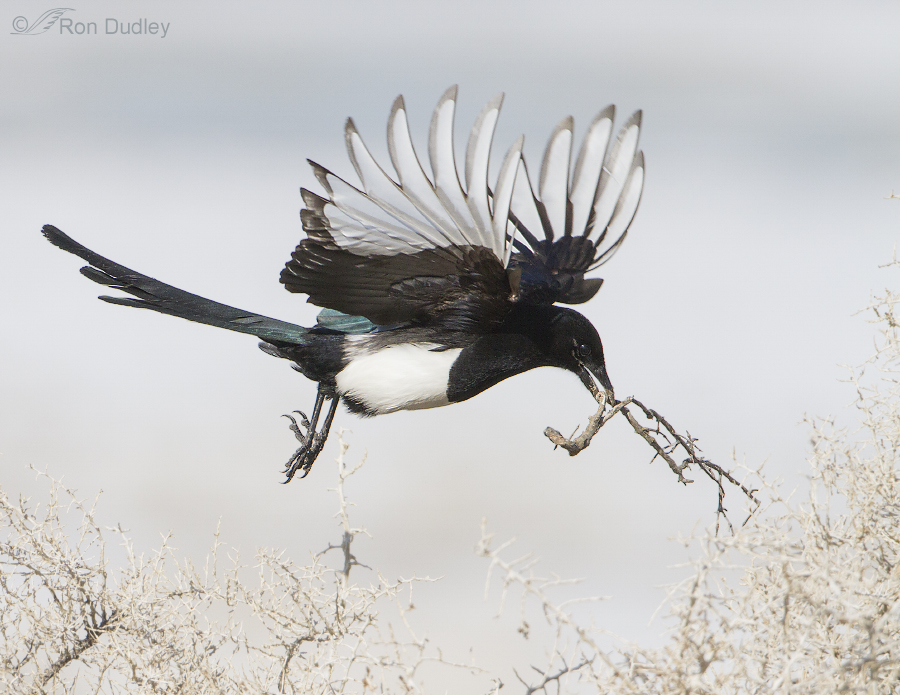


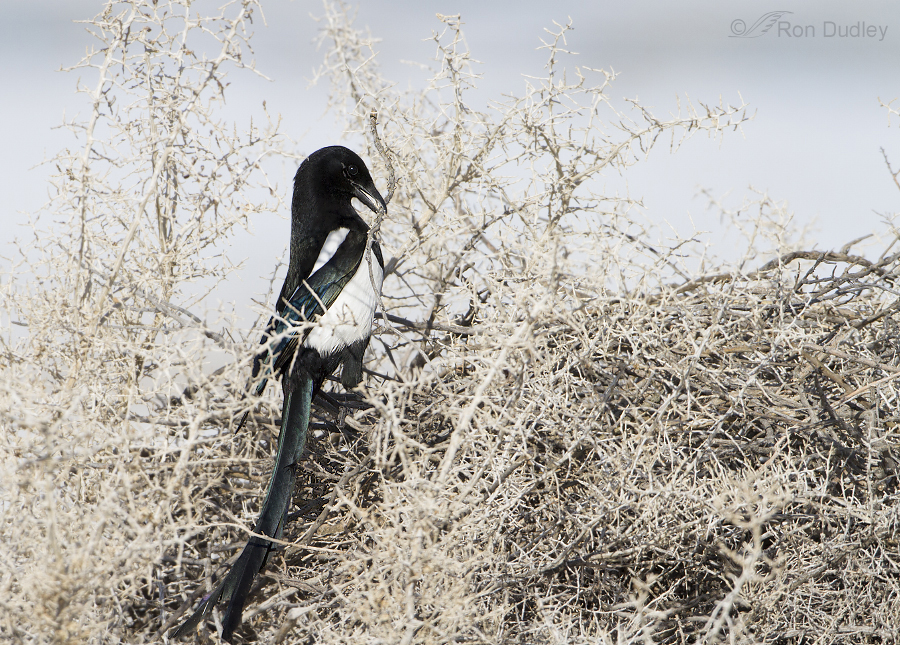
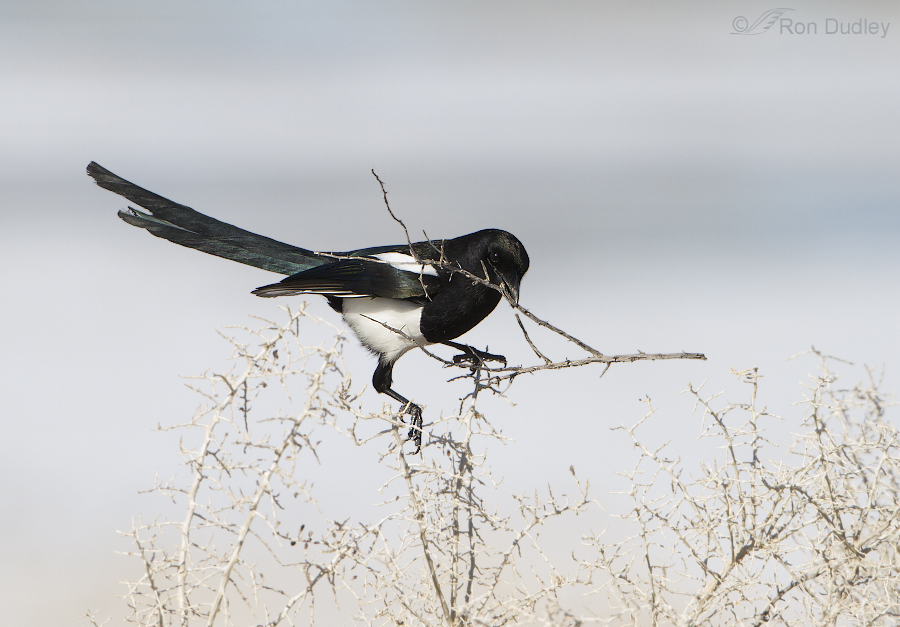

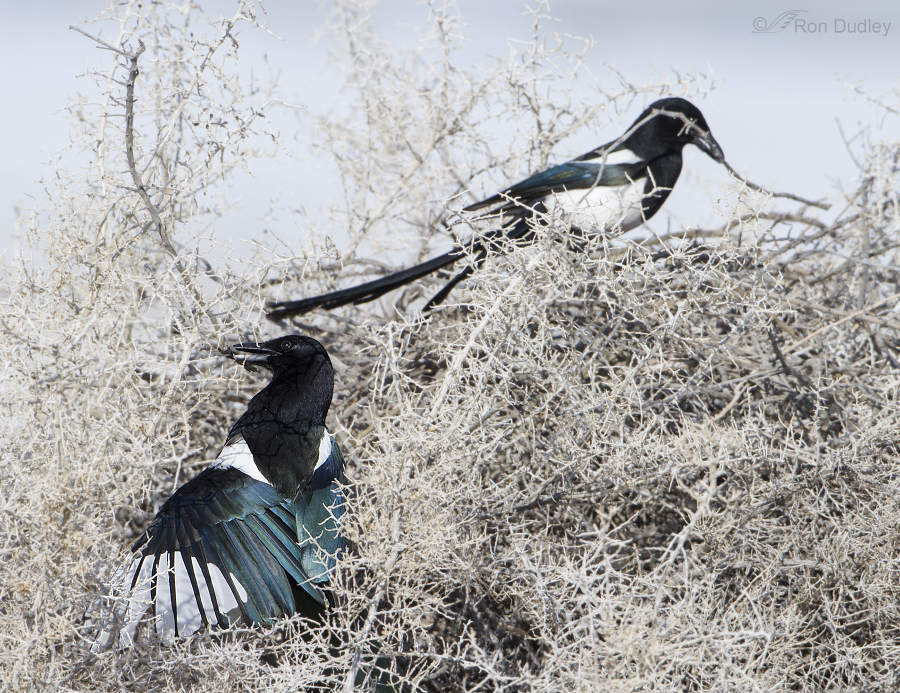
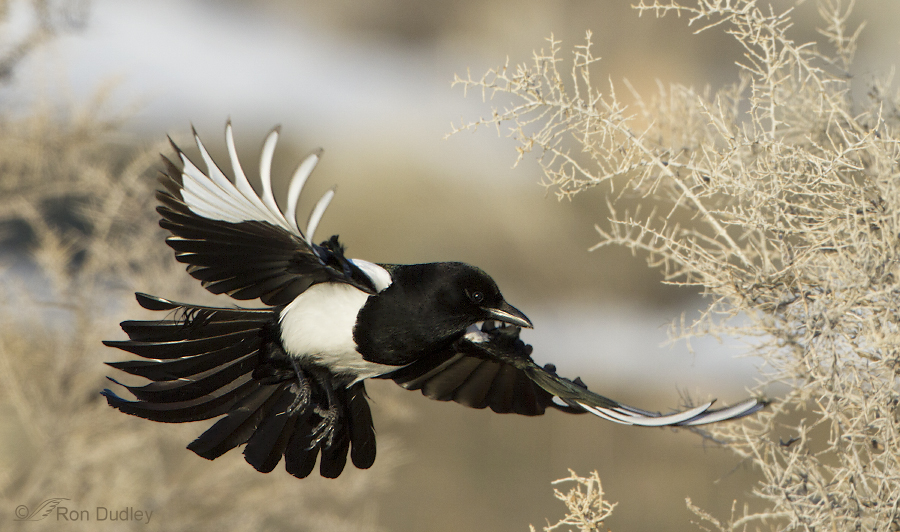
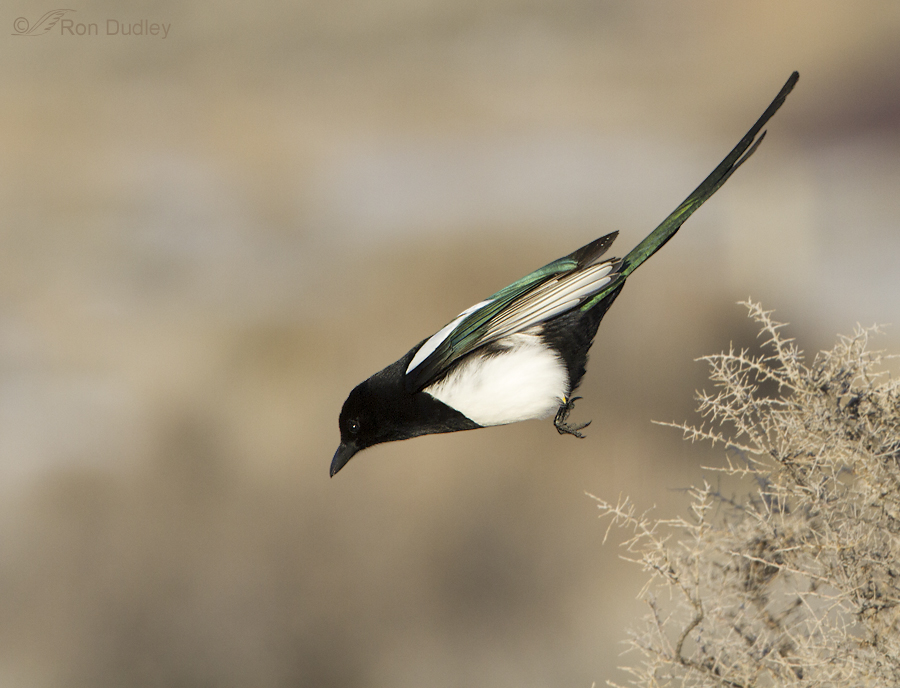
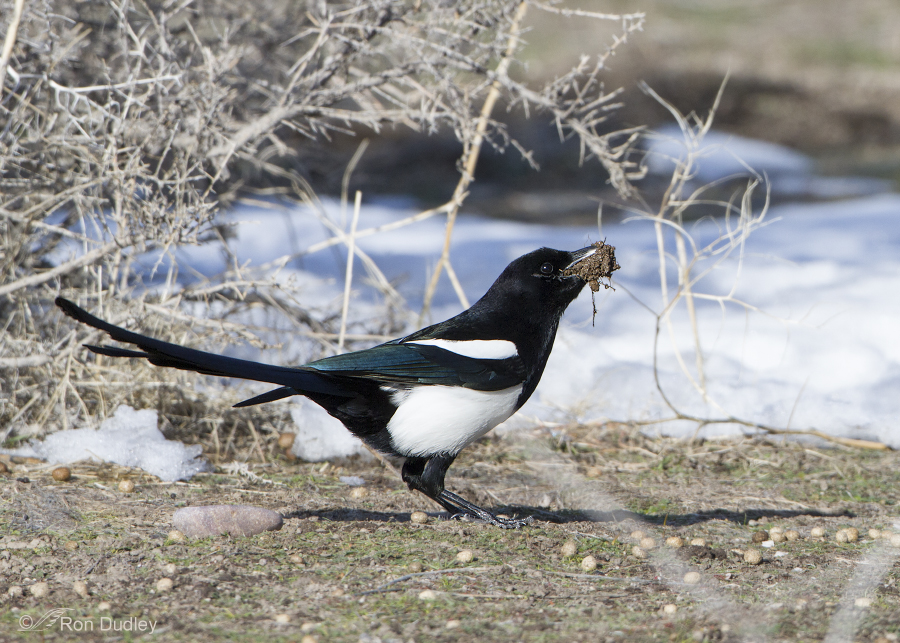
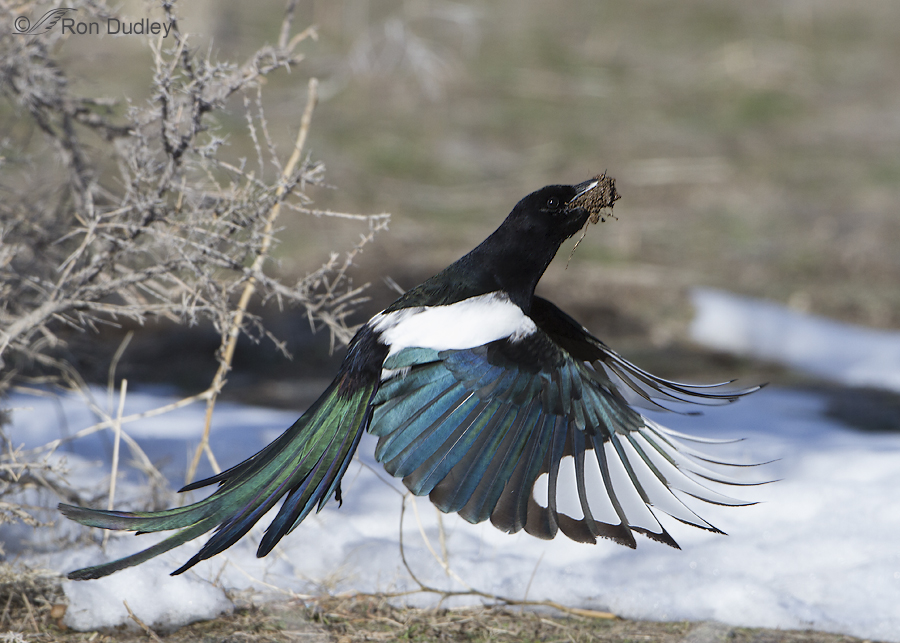
i’ve always enjoyed watching magpies…there’s something kind of sassy and irreverent about them. My Pine Ridge friends often saw a one-legged one they called “Lefty” in and around the big cottonwood. They saw him (?) for quite a while and he seemed to hold his own in spite of his leg loss. He was particularly interested in the beef bones they put out for the dogs…all “drop offs”. I didn’t realize how beautiful these birds actually are…as beautiful as any flashy peacock to me. Don’t know how I overlooked/missed these pictures before. they’re wonderful!
OOps! I forgot I missed the post about your complaining about nicktating membrames. What was the complaint? IO’m trying to educate myself about them, I know so little.
Thanks!
Charlotte
Thank you, Charlotte. I was complaining about the membrane because when it’s closed it detracts from the image aesthetically – especially with some of the corvids which have the blue-white membrane.
Been out of range and just catching up. What a wonderful series! Thanks so very much for sharing your talent and expertise with us!
You will be shocked and surprised (not) to hear that I loved this post. Our magpies nest is nothing like as complex. The nest is a bowl-shaped structure made of sticks and lined with softer material such as grass and bark. Near human habitation, synthetic material may be incorporated. The nest is generally built high in a tree – often in an exposed position. The female has sole nest-building responsibility, although the male will protect the nest and the nestlings – often aggressively.
I “saw” one of your Australian magpies today, Elephants Child and thought of you. It’s on an avian critique forum that I participate in. Here’s the link (though I don’t know that it will work).
http://www.naturephotographers.net/imagecritique/ic.cgi?a=vp&pr=203611&CGISESSID=04b9a4ba8e40db74584747af79451e40&u=8662
That link did work, thank you very much. Not only that, but it was a ‘local’ bird since I live in Canberra. Magpies are less spectacular than some of our birds, but I have a huge soft spot for them, and their call is enchanting.
I wish I had a teacher like you when I was in school.
That melted my heart, Janice…
Gorgeous images!
Thank you, Cindy. I’m glad you like them.
Fantastic! Love those magpies!
Thanks, Teri.
Wonderful picture story. I grew up around magpies on our farm. In fact, as kids, my brothers and I regularly watched the nests of magpies and other corvids for nesting activity. When the time was right, we would climb the tree and take a nearly grown baby from the nest which we then raised as a pet. Over the years, we raised magpies, crows and once a raven. The raven was the best pet. Also the heaviest as he rode on our shoulder or our head! By fall, they would join with others of their species, but our summers were spent enjoying our intelligent friends!
Sounds like you had some interesting experiences with corvids when you were a child, Peggy.
Gorgeous magpie shots, Ron — and fascinating commentary. You’re a great advocate for our little feathered friends.
Thanks very much, Howard.
Ron, wonderful series! I’ve recommended it to all the Corvids in our area: Nest Building 101.
Seriously, fantastic information. I’m in the process of locating and tracking Scrub Jay nests in the area this year. They appear to have a similar construction routine, although their nests are not as elaborate as the Magpie’s.
I think the corvids are smart enough to act on your recommendation, Wally. Good luck with the Scrub Jays!
The last shot is particularly interesting and the colors are beautiful. I really enjoy these birds, and their antics. Thank you for this entertaining set of detailed shots.
I like that last shot too, Tana. Don’t think I’ve ever seen more iridesence on a magpie before.
Fascinating series of photos. I enjoyed watching these birds when I was in Idaho. I’ve wondered about the appearance of the eyes several times when photographing crows so your mention of the nictitating membrane answered that question. Your photos are wonderful.
Glad I could help with the explanation of the nictitating membrane, Ilona.
Thank you Ron, for sharing all your diligent work. I truly enjoy this early morning look at birds in the wild.
Diana, I’m happy to hear that I occasionally contribute to a pleasant morning for you.
What joy!!!!!!!! I’m just in awe!!!! Ron, may I ask where you’re located?
Thank you, Lois. I live in northern Utah. These shots were taken near the shore of the Great Salt Lake.
Really enjoyed this series of pictures! I especially like the one where both birds are bringing twigs to the nest. I watched the eagle nest at Norfolk Botantical Garden before all the horrible things that happened there occurred. It was fascinating watching them bring sometimes very large limbs and the male especially would sometimes struggle for some time trying to get the limb right where he wanted it to go. It seemed sometimes he just made do and tried to leave it alone, but often when he was incubating the eggs he’d glance around and seem to see that troublesome limb again and work at it some more.
That must have been fascinating to watch, Leisa. Funny about that male who couldn’t “forget” about imperfections in his construction. Reminds me of me and some of my woodworking projects – any little imperfection stands out like a sore thumb to me but others don’t even notice them.
Beautiful clarity….! Not to mention you made me look up Magpies,lol.
I didn’t know they were related to Crows, but really, it does makes sense.
Yes, magpies, crows ravens, jays, nutcrackers and a few others are all corvids – among the most intelligent of birds.
Thank you for your explaining the nest building process of the BBMagpies Ron and with your wonderful photography ties it all together.
Thanks, John. Glad you enjoyed the nest info.